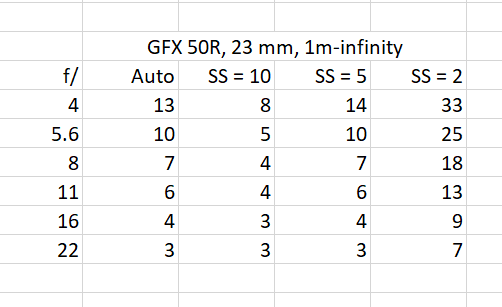There’s a new mode in the firmware released today for the GFX 50S, 50R, and 100: auto focus bracketing. You set the near distance, the far distance, and the interval, and the camera bangs away between those focal points.
But what does it use for a step size?
Using a GFX 50R and the 23mm f/4 lens, I counted the number of exposures the camera made to go from 1 meter to infinity in auto mode, and manual mode with step sizes of 10, 5, and 2. The results:
So, the answer to the question is, the GFX chooses a step size of about 5 in auto mode. That gives a worst case CoC of 5 um within the stack, which should be fine for all but the most critical work.
By the way, you can use the auto bracketing feature to get the number of exposures you’ll need if you’re using other than five for a step size.
- Focus on the near, set A.
- Focus on the far, set B.
- Check the number of exposures by starting the series.
- Cancel the series, because you now have the number of exposures.
- Put the camera in manual bracketing mode.
- Choose a step size.
- Set the number of exposures to the number that the camera was going to do in auto mode times 5 over your chosen step size. Round up.
- Focus on the near.
- Trip the shutter.

I finally got focus but to work but I don’t know how to stop it.
I don’t know what you mean.